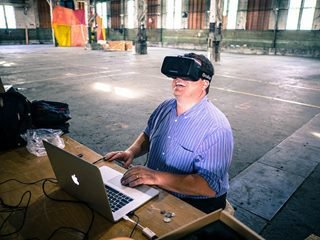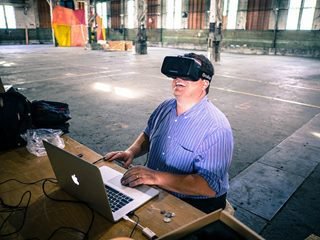
A recent study by Gartner regarding the use of augmented reality (AR) and virtual reality (VR) suggests that by next year, 100 million consumers will be using both technologies for shopping online and in-store. Gartner writes in a statement that both have the potential to shake up the customer experience by individualizing retailers’ offers and enabling customers to visualize products in different settings — if the technology is developed enough and if the infrastructure behind can support it.
To date this has been a struggle largely because to support AR and VR environments devices need to be able to access and manage huge amounts of data, among other things. The higher throughput of 5G will be necessary for VR and AR content that’s streamed from the cloud, and with access to 5G getting easier and more common, it may be that AR and VR will go mainstream with it. “Retailers are under increasing pressure to explain the purpose of physical stores, and take control of the fulfillment and return process for cross-channel execution. At the same time, consumers are progressively defining the value provided by the experiences they receive from retailers. As a result of these pressures, retailers are turning to AR and VR to offer customers a unified retail experience inside and outside retail stores,” according to the Gartner statement.
There is good reason to be optimistic about 5G, its capabilities can support multiple uses cases, such as real-time rendering for immersive video, shorter download and setup times and extension of brands and shopping experiences beyond stores.
Related Article: What is 5G, And How Will It Work?
5G Solves High-Bandwidth Demands Of AR
Mangala Bhattacharjee, senior marketing manager at Research on Global Markets, which has a specialty in research, evaluation and analysis of 5G technology, believes that 5G as a technology inherently brings aspects such as high-speed, ultra-low latency and high bandwidth — all in a wireless communication network. He believes that the initial implementations of AR applications in the consumer (navigation, virtual tourism, immersive gaming) and at the enterprise level (digital twins for predictive maintenance in the manufacturing sector, remote surgeries in healthcare) will become seamless once 5G networks become widespread. “Having said this, AR/VR technologies are now moving into the realms of what is termed as ‘Mixed Realities’ where augmented and virtual realities will be combined with the real world to create an advance immersive experience, which will demand a lot of parallel enabling technologies,” he said.
True AR/VR implementations depend on various factors such as computational requirements, form factor, user mobility, haptic requirements (haptics is any form of interaction involving touch), image acquisition and processing, lossless data compression and low power precise positioning, among others. Different approaches in machine learning/deep learning models are being devised for obtaining image augmentation and performing edge operations.
“In our opinion, while 5G will definitely meet some of the aspects (bandwidth, low-latency, speed), advancements in the above mentioned areas are also essential to the overall success of advance AR/VR implementation,” he said.
Even the common consumer would benefit immediately from 5G since the mass hysteria about single digit millisecond (ms) to transfer data is misleading. The architecture requires edge data centers for meeting the kind of latency that is being set. Dheeraj Ramella, the chief technologist at VoltDB, outlined four reason why this is the case.
- Data Transfer Speed – For a VR application or immersive gaming to happen, the whole 360-degree frame information needs to be sent with below 20 ms lag, which is shown to cause nausea in a VR viewing setup. Even if the frame splices are being sent as the head is moving, it is still a considerable chunk of data that needs to travel from some content delivery network (CDN) endpoint through the towers to the user equipment and get rendered.
- Data Congestion – The higher bandwidth consumption to deliver 4K or UHD video to provide a non-pixelated and non-lagged experience to the player will cause massive congestion if a popular game is being played in VR mode by a number of players beyond a certain threshold.
- High Frequency Band Required – The highest bandwidths like 10Gbps and 40Gbps is possible only through higher frequency bands. But these have interference challenges that are still unaddressed. Typical towers and small cells will not be able to sustain the kind of data transfer rates advertised with the density of connected devices advertised.
- New Endpoints – This can probably be overcome by installing several more CDN endpoints almost like near edge processing in Industrial IoT.
“On the other hand, medical and industrial diagnosis can be areas where AR/VR can play a very heavy role since these would be in a closed environment where interference can be eliminated and all necessary data and content will be indoors, so that a high frequency high transfer rate network can be established and the density of devices for such a setup would not be onerous,” he said.
Related Article: 6 Ways Businesses Are Using Augmented and Virtual Reality Today
5G Will Make AR and VR Faster
5G should make AR and VR technologies much faster, with much more data flow. With easier and more accessible use, for a variety of different functions (besides video gaming), widespread adoption seems likely.
However, 5G will take a while to actually benefit the consumer. Many are weary that 5G will be mostly benefiting the cable companies, which will not have to install pricey fiber optic cables to places with poor service, and they will save a lot of money down the road, especially with lowered installation costs of 5G cells compared to 4G cell towers, said Michelle Klein of DefenderShield.
On another note, 5G also has radiation concerns because it is the first wireless network to employ a millimeter wave, which is the smallest and fastest frequency yet. Previous wireless networks have been proven to have adverse biological effects on cells in your body (DNA fragmentation, oxidative stress, cancerous tumors), and can alter hormone and neurotransmitter levels in your brain that regulate many processes in your body.
5G health effects have not been studied yet, but might exacerbate the effects seen in previous generations. Even with no research, the push for 5G adoption is being led by telecom companies that want to cut costs and grow their networks to all corners of the globe. 5G is not trying to be implemented this fast just too simply satisfy the consumers’ needs for even faster speeds that we already have now.
Augmented reality technology is used in various markets including commercial, gaming, retail and e-commerce. Some of the key players in the space are Apple, Sony, Microsoft, Google and Samsung Electronics.
What may be causing stagnation in sales of technology using AR, such as headsets, is that currently the products offered only address a small market of those interested in using the technology for reasons related to leisure, such as gaming
However, Apple, Google, Facebook and Snapchat already offer features and apps where consumers can use AR in their daily lives. Meanwhile, many technological developments are chipping away at AR obstacles, with moves toward improved ease of use, enhanced developer tools, improved networking, greater utility, higher performance and lower costs — and, of course, 5G.

